Leica Q2 vs Olympus E-M5 III
The Leica Q2 and the Olympus OM-D E-M5 Mark III are two enthusiast cameras that were announced, respectively, in March 2019 and October 2019. The Q2 is a fixed lens compact, while the E-M5 III is a mirrorless interchangeable lens camera. The cameras are based on a full frame (Q2) and a Four Thirds (E-M5 III) sensor. The Leica has a resolution of 46.7 megapixels, whereas the Olympus provides 20.2 MP.
Below is an overview of the main specs of the two cameras as a starting point for the comparison.

Check Q2 price at
amazon.com

Check E-M5 III offers at
ebay.com
Going beyond this snapshot of core features and characteristics, what are the differences between the Leica Q2 and the Olympus OM-D E-M5 Mark III? Which one should you buy? Read on to find out how these two cameras compare with respect to their body size, their imaging sensors, their shooting features, their input-output connections, and their reception by expert reviewers.
Body comparison
The side-by-side display below illustrates the physical size and weight of the Leica Q2 and the Olympus E-M5 III. The two cameras are presented according to their relative size. Three consecutive views from the front, the top, and the rear side are shown. All size dimensions are rounded to the nearest millimeter.
The E-M5 III can be obtained in two different colors (black, silver), while the Q2 is only available in black.
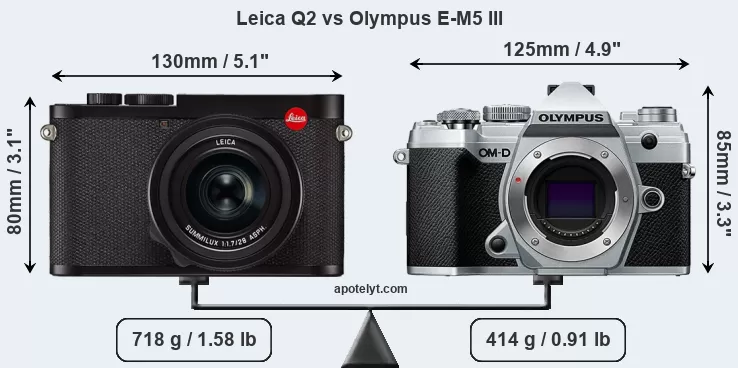
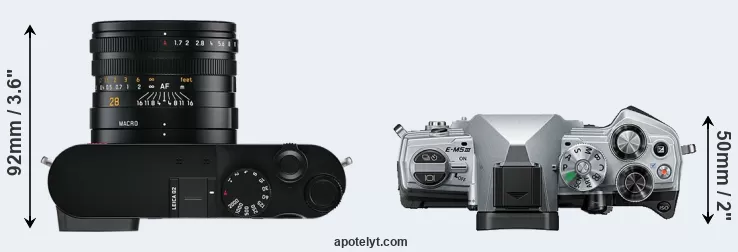
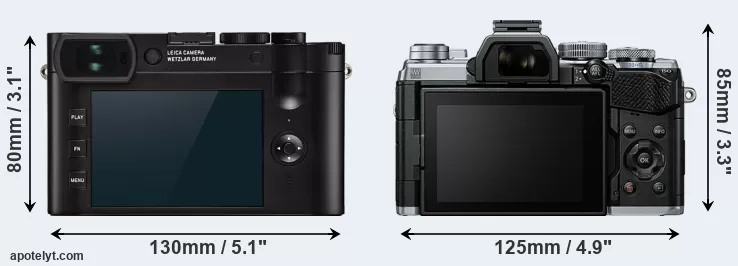
If the front view area (width x height) of the cameras is taken as an aggregate measure of their size, the Olympus E-M5 III is somewhat larger (2 percent) than the Leica Q2. In this context, it is worth noting that both cameras are splash and dust-proof and can, hence, be used in inclement weather conditions or harsh environments.
The above size and weight comparisons are to some extent incomplete and possibly misleading, as the Q2 has a lens built in, whereas the E-M5 III is an interchangeable lens camera that requires a separate lens. Attaching the latter will add extra weight and bulk to the setup. You can compare the optics available for the E-M5 III and their specifications in the Micro Four Thirds Lens Catalog.
Concerning battery life, the Q2 gets 370 shots out of its Leica BP-SCL4 battery, while the E-M5 III can take 310 images on a single charge of its Olympus BLS-50 power pack. The power pack in the E-M5 III can be charged via the USB port, which can be very convenient when travelling.
The table below summarizes the key physical specs of the two cameras alongside a broader set of comparators. In case you want to display and compare another camera duo, you can use the CAM-parator app to select your camera combination among a large number of options.

| Camera Model |
Camera Width |
Camera Height |
Camera Depth |
Camera Weight |
Battery Life |
Weather Sealing |
Camera Launch |
Launch Price (USD) |
Street Price |
||
|---|---|---|---|---|---|---|---|---|---|---|---|
| 1. | Leica Q2 | 130 mm | 80 mm | 92 mm | 718 g | 370 | Y | Mar 2019 | 4,995 | amazon.com | |
| 2. | Olympus E-M5 III | 125 mm | 85 mm | 50 mm | 414 g | 310 | Y | Oct 2019 | 1,199 | ebay.com | |
| 3. | Canon R | 139 mm | 98 mm | 84 mm | 660 g | 370 | Y | Sep 2018 | 2,299 | ebay.com | |
| 4. | Fujifilm GFX 50R | 161 mm | 97 mm | 66 mm | 775 g | 400 | Y | Sep 2018 | 4,499 | ebay.com | |
| 5. | Leica M Typ 262 | 139 mm | 80 mm | 42 mm | 680 g | 400 | Y | Nov 2015 | 5,195 | ebay.com | |
| 6. | Leica M10 | 139 mm | 80 mm | 39 mm | 660 g | 210 | Y | Jan 2017 | 6,595 | ebay.com | |
| 7. | Leica M10-P | 139 mm | 80 mm | 39 mm | 660 g | 210 | Y | Aug 2018 | 7,995 | ebay.com | |
| 8. | Leica M10-R | 139 mm | 80 mm | 39 mm | 660 g | 210 | Y | Jul 2020 | 8,295 | ebay.com | |
| 9. | Leica Q Typ 116 | 130 mm | 80 mm | 93 mm | 640 g | 300 | n | Jun 2015 | 4,249 | ebay.com | |
| 10. | Leica Q3 | 130 mm | 80 mm | 93 mm | 743 g | 350 | Y | May 2023 | 5,995 | amazon.com | |
| 11. | Nikon Z7 | 134 mm | 101 mm | 67 mm | 675 g | 330 | Y | Aug 2018 | 3,399 | ebay.com | |
| 12. | Olympus E-M1 | 130 mm | 94 mm | 63 mm | 497 g | 350 | Y | Sep 2013 | 1,399 | ebay.com | |
| 13. | Olympus E-M5 | 122 mm | 89 mm | 43 mm | 425 g | 360 | Y | Feb 2012 | 1,299 | ebay.com | |
| 14. | Olympus E-M5 II | 124 mm | 85 mm | 45 mm | 469 g | 310 | Y | Feb 2015 | 1,099 | ebay.com | |
| 15. | Olympus PEN-F | 125 mm | 72 mm | 37 mm | 427 g | 330 | n | Jan 2016 | 1,199 | ebay.com | |
| 16. | Panasonic GX8 | 133 mm | 78 mm | 63 mm | 487 g | 330 | Y | Jul 2015 | 1,199 | ebay.com | |
| 17. | Zeiss ZX1 | 142 mm | 93 mm | 46 mm | 800 g | 250 | n | Sep 2018 | 5,999 | ebay.com | |
| Note: Measurements and pricing do not include easily detachable parts, such as add-on or interchangeable lenses or optional viewfinders. | |||||||||||
Any camera decision will naturally be influenced heavily by the price. The manufacturer’s suggested retail prices give an idea on the placement of the camera in the maker’s lineup and the broader market. Normally, street prices remain initially close to the MSRP, but after a couple of months, the first discounts appear. Later in the product cycle and, in particular, when the replacement model is about to appear, further discounting and stock clearance sales often push the camera price considerably down. Then, after the new model is out, very good deals can frequently be found on the pre-owned market.
Sensor comparison
The imaging sensor is at the core of digital cameras and its size is one of the main determining factors of image quality. A large sensor will tend to have larger individual pixels that provide better low-light sensitivity, wider dynamic range, and richer color-depth than smaller pixel-units in a sensor of the same technological generation. Further, a large sensor camera will give the photographer additional creative options when using shallow depth-of-field to isolate a subject from its background. On the downside, larger sensors are more costly to manufacture and tend to lead to bigger and heavier cameras and lenses.
Of the two cameras under consideration, the Leica Q2 features a full frame sensor and the Olympus E-M5 III a Four Thirds sensor. The sensor area in the E-M5 III is 74 percent smaller. As a result of these sensor size differences, the cameras have a format factor of, respectively, 1.0 and 2.0. The sensor in the Q2 has a native 3:2 aspect ratio, while the one in the E-M5 III offers a 4:3 aspect.
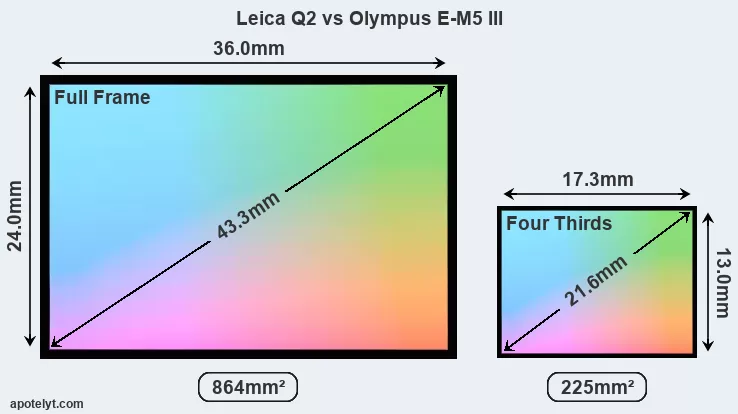
With 46.7MP, the Q2 offers a higher resolution than the E-M5 III (20.2MP), but the Q2 nevertheless has larger individual pixels (pixel pitch of 4.30μm versus 3.34μm for the E-M5 III) due to its larger sensor. However, the E-M5 III is a somewhat more recent model (by 7 months) than the Q2, and its sensor might have benefitted from technological advances during this time that enhance the light gathering capacity of its pixels. Coming back to sensor resolution, it should be mentioned that neither of the two cameras has an anti-alias filter installed, so they are able to capture all the detail the sensor resolves.
The resolution advantage of the Leica Q2 implies greater flexibility for cropping images or the possibility to print larger pictures. The maximum print size of the Q2 for good quality output (200 dots per inch) amounts to 41.8 x 27.9 inches or 106.3 x 70.9 cm, for very good quality (250 dpi) 33.5 x 22.3 inches or 85 x 56.7 cm, and for excellent quality (300 dpi) 27.9 x 18.6 inches or 70.8 x 47.3 cm. The corresponding values for the Olympus E-M5 III are 25.9 x 19.4 inches or 65.8 x 49.4 cm for good quality, 20.7 x 15.6 inches or 52.7 x 39.5 cm for very good quality, and 17.3 x 13 inches or 43.9 x 32.9 cm for excellent quality prints.
The E-M5 III has on-sensor phase detect pixels, which results in fast and reliable autofocus acquisition even during live view operation.
Unlike the Q2, the E-M5 III has the capacity to capture high quality composite images (80MP) by combining multiple shots after shifting its sensor by miniscule distances. This multi-shot, pixel-shift mode is most suitable for photography of stationary objects (landscapes, studio scenes).
The Leica Q2 has a native sensitivity range from ISO 50 to ISO 50000. The corresponding ISO settings for the Olympus OM-D E-M5 Mark III are ISO 200 to ISO 25600, with the possibility to increase the ISO range to 64-25600.
Technology-wise, both cameras are equipped with CMOS (Complementary Metal–Oxide–Semiconductor) sensors. Both cameras use a Bayer filter for capturing RGB colors on a square grid of photosensors. This arrangement is found in most digital cameras.
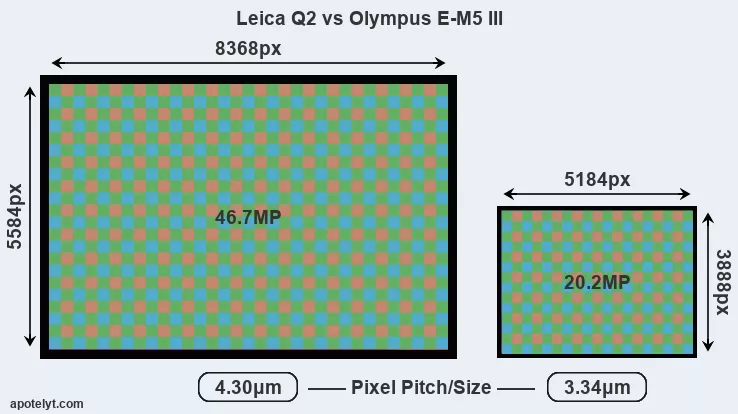
For many cameras, data on sensor performance has been reported by DXO Mark. This service determines an overall sensor rating, as well as sub-scores for low-light sensitivity ("DXO Sports"), dynamic range ("DXO Landscape"), and color depth ("DXO Portrait"). The following table provides an overview of the physical sensor characteristics, as well as the sensor quality measurements for a selection of comparators.

| Camera Model |
Sensor Class |
Resolution (MP) |
Horiz. Pixels |
Vert. Pixels |
Video Format |
DXO Portrait |
DXO Landscape |
DXO Sports |
DXO Overall |
||
|---|---|---|---|---|---|---|---|---|---|---|---|
| 1. | Leica Q2 | Full Frame | 46.7 | 8368 | 5584 | 4K/30p | 26.4 | 13.5 | 2491 | 96 | |
| 2. | Olympus E-M5 III | Four Thirds | 20.2 | 5184 | 3888 | 4K/30p | 23.3 | 13.1 | 1324 | 76 | |
| 3. | Canon R | Full Frame | 30.1 | 6720 | 4480 | 4K/30p | 24.5 | 13.5 | 2742 | 89 | |
| 4. | Fujifilm GFX 50R | Medium Format | 51.1 | 8256 | 6192 | 1080/30p | 25.7 | 14.4 | 3169 | 98 | |
| 5. | Leica M Typ 262 | Full Frame | 23.7 | 5952 | 3976 | none | 24.8 | 13.7 | 2478 | 90 | |
| 6. | Leica M10 | Full Frame | 23.8 | 5952 | 3992 | none | 24.4 | 13.2 | 2133 | 86 | |
| 7. | Leica M10-P | Full Frame | 23.8 | 5952 | 3992 | none | 25.1 | 14.1 | 2739 | 93 | |
| 8. | Leica M10-R | Full Frame | 40.9 | 7864 | 5200 | none | 25.3 | 14.3 | 2924 | 95 | |
| 9. | Leica Q Typ 116 | Full Frame | 24.0 | 6000 | 4000 | 1080/60p | 24.3 | 12.7 | 2221 | 85 | |
| 10. | Leica Q3 | Full Frame | 60.3 | 9528 | 6328 | 8K/30p | 25.4 | 14.7 | 3216 | 96 | |
| 11. | Nikon Z7 | Full Frame | 45.4 | 8256 | 5504 | 4K/30p | 26.3 | 14.6 | 2668 | 99 | |
| 12. | Olympus E-M1 | Four Thirds | 15.9 | 4608 | 3456 | 1080/30p | 23.0 | 12.7 | 757 | 73 | |
| 13. | Olympus E-M5 | Four Thirds | 15.9 | 4608 | 3456 | 1080/60i | 22.8 | 12.3 | 826 | 71 | |
| 14. | Olympus E-M5 II | Four Thirds | 15.9 | 4608 | 3456 | 1080/60p | 23.0 | 12.5 | 842 | 73 | |
| 15. | Olympus PEN-F | Four Thirds | 20.2 | 5184 | 3888 | 1080/60p | 23.1 | 12.4 | 894 | 74 | |
| 16. | Panasonic GX8 | Four Thirds | 20.2 | 5184 | 3888 | 4K/30p | 23.5 | 12.6 | 806 | 75 | |
| 17. | Zeiss ZX1 | Full Frame | 37.4 | 7488 | 4992 | 4K/30p | 25.2 | 14.1 | 2759 | 94 | |
| Note: DXO values in italics represent estimates based on sensor size and age. | |||||||||||
Many modern cameras are not only capable of taking still images, but can also record movies. The two cameras under consideration both have sensors whose read-out speed is fast enough to capture moving pictures, and both provide the same movie specifications (4K/30p).
Feature comparison
Apart from body and sensor, cameras can and do differ across a variety of features. The two cameras under consideration are similar with respect to both having an electronic viewfinder. However, the one in the Q2 offers a substantially higher resolution than the one in the E-M5 III (3680k vs 2360k dots). The table below summarizes some of the other core capabilities of the Leica Q2 and Olympus E-M5 III in connection with corresponding information for a sample of similar cameras.

| Camera Model |
Viewfinder (Type or 000 dots) |
Control Panel (yes/no) |
LCD Specifications (inch/000 dots) |
LCD Attach- ment |
Touch Screen (yes/no) |
Max Shutter Speed * |
Max Shutter Flaps * |
Built-in Flash (yes/no) |
Built-in Image Stab |
||
|---|---|---|---|---|---|---|---|---|---|---|---|
| 1. | Leica Q2 | 3680 | n | 3.0 / 1040 | fixed | Y | 1/2000s | 10.0/s | n | Y | |
| 2. | Olympus E-M5 III | 2360 | n | 3.0 / 1040 | swivel | Y | 1/8000s | 10.0/s | n | Y | |
| 3. | Canon R | 3690 | Y | 3.2 / 2100 | swivel | Y | 1/8000s | 8.0/s | n | n | |
| 4. | Fujifilm GFX 50R | 3690 | n | 3.2 / 2360 | tilting | Y | 1/4000s | 3.0/s | n | n | |
| 5. | Leica M Typ 262 | optical | n | 3.0 / 921 | fixed | n | 1/4000s | 3.0/s | n | n | |
| 6. | Leica M10 | optical | n | 3.0 / 1037 | fixed | n | 1/4000s | 5.0/s | n | n | |
| 7. | Leica M10-P | optical | n | 3.0 / 1037 | fixed | Y | 1/4000s | 5.0/s | n | n | |
| 8. | Leica M10-R | optical | n | 3.0 / 1037 | fixed | Y | 1/4000s | 4.5/s | n | n | |
| 9. | Leica Q Typ 116 | 3680 | n | 3.0 / 1040 | fixed | Y | 1/2000s | 10.0/s | n | Y | |
| 10. | Leica Q3 | 5760 | n | 3.0 / 1840 | tilting | Y | 1/2000s | 15.0/s | n | Y | |
| 11. | Nikon Z7 | 3690 | Y | 3.2 / 2100 | tilting | Y | 1/8000s | 9.0/s | n | Y | |
| 12. | Olympus E-M1 | 2360 | n | 3.0 / 1037 | tilting | Y | 1/8000s | 10.0/s | n | Y | |
| 13. | Olympus E-M5 | 1440 | n | 3.0 / 610 | tilting | Y | 1/4000s | 9.0/s | n | Y | |
| 14. | Olympus E-M5 II | 2360 | n | 3.0 / 1037 | swivel | Y | 1/8000s | 10.0/s | n | Y | |
| 15. | Olympus PEN-F | 2360 | n | 3.0 / 1037 | swivel | Y | 1/8000s | 10.0/s | n | Y | |
| 16. | Panasonic GX8 | 2360 | n | 3.0 / 1040 | swivel | Y | 1/8000s | 10.0/s | n | Y | |
| 17. | Zeiss ZX1 | 6221 | n | 4.3 / 2765 | fixed | Y | 1/1000s | 3.0/s | n | n | |
| Note: *) Information refers to the mechanical shutter, unless the camera only has an electronic one. | |||||||||||
The reported shutter speed information refers to the use of the mechanical shutter. Yet, some cameras only have an electronic shutter, while others have an electronic shutter in addition to a mechanical one. In fact, both cameras under consideration feature an electronic shutter, which makes completely silent shooting possible. However, this mode is less suitable for photographing moving objects (risk of rolling shutter) or shooting under artificial light sources (risk of flickering).
The Leica Q2 and the Olympus E-M5 III both have an intervalometer built-in. This enables the photographer to capture time lapse sequences, such as flower blooming, a sunset or moon rise, without purchasing an external camera trigger and related software.
Concerning the storage of imaging data, both the Q2 and the E-M5 III write their files to SDXC cards. Both cameras support UHS-II cards, which provide for Ultra High Speed data transfer of up to 312 MB/s.
Connectivity comparison
For some imaging applications, the extent to which a camera can communicate with its environment can be an important aspect in the camera decision process. The table below provides an overview of the connectivity of the Leica Q2 and Olympus OM-D E-M5 Mark III and, in particular, the interfaces the cameras (and selected comparators) provide for accessory control and data transfer.

| Camera Model |
Hotshoe Port |
Internal Mic / Speaker |
Microphone Port |
Headphone Port |
HDMI Port |
USB Port |
WiFi Support |
NFC Support |
Bluetooth Support |
||
|---|---|---|---|---|---|---|---|---|---|---|---|
| 1. | Leica Q2 | Y | stereo / mono | - | - | - | - | Y | - | Y | |
| 2. | Olympus E-M5 III | Y | stereo / mono | Y | - | micro | 2.0 | Y | - | Y | |
| 3. | Canon R | Y | stereo / mono | Y | Y | mini | 3.1 | Y | - | Y | |
| 4. | Fujifilm GFX 50R | Y | stereo / mono | Y | Y | micro | 3.0 | Y | - | Y | |
| 5. | Leica M Typ 262 | Y | - / - | - | - | - | 2.0 | - | - | - | |
| 6. | Leica M10 | Y | - / - | - | - | - | - | Y | - | - | |
| 7. | Leica M10-P | Y | - / - | - | - | - | - | Y | - | - | |
| 8. | Leica M10-R | Y | - / - | - | - | - | - | Y | - | - | |
| 9. | Leica Q Typ 116 | Y | stereo / mono | - | - | micro | 2.0 | Y | Y | - | |
| 10. | Leica Q3 | Y | stereo / mono | - | - | micro | 3.1 | Y | - | Y | |
| 11. | Nikon Z7 | Y | stereo / mono | Y | Y | micro | 3.1 | Y | - | Y | |
| 12. | Olympus E-M1 | Y | stereo / mono | Y | - | micro | 2.0 | Y | - | - | |
| 13. | Olympus E-M5 | Y | stereo / mono | - | - | mini | 2.0 | - | - | - | |
| 14. | Olympus E-M5 II | Y | stereo / mono | Y | - | micro | 2.0 | Y | - | - | |
| 15. | Olympus PEN-F | Y | stereo / mono | - | - | micro | 2.0 | Y | - | - | |
| 16. | Panasonic GX8 | Y | stereo / mono | Y | - | micro | 2.0 | Y | Y | - | |
| 17. | Zeiss ZX1 | Y | stereo / mono | - | - | - | 3.1 | Y | Y | Y |
It is notable that the E-M5 III has a microphone port, which can help to improve the quality of audio recordings by attaching an external microphone. The Q2 does not feature such a mic input.
The Q2 is a recent model that features in the current product line-up of Leica. In contrast, the E-M5 III has been discontinued (but can be found pre-owned on ebay). As a replacement in the same line of cameras, the E-M5 III was succeeded by the OM System OM-5. Further information on the features and operation of the Q2 and E-M5 III can be found, respectively, in the Leica Q2 Manual (free pdf) or the online Olympus E-M5 III Manual.
Review summary
So what is the bottom line? Is there a clear favorite between the Leica Q2 and the Olympus E-M5 III? Which camera is better? The listing below highlights the relative strengths of the two models.

Reasons to prefer the Leica Q2:
- More detail: Offers more megapixels (46.7 vs 20.2MP) with a 55% higher linear resolution.
- Better image quality: Features bigger pixels on a larger sensor for higher quality imaging.
- Richer colors: The pixel size advantage translates into images with better, more accurate colors.
- More dynamic range: Larger pixels capture a wider spectrum of light and dark details.
- Better low-light sensitivity: Larger pixels means good image quality even under poor lighting.
- More detailed viewfinder: Has higher resolution electronic viewfinder (3680k vs 2360k dots).
- Larger viewfinder image: Features a viewfinder with a higher magnification (0.76x vs 0.68x).
- Ready to shoot: Has a lens built-in, whereas the E-M5 III requires a separate lens.
- Longer lasting: Can take more shots (370 versus 310) on a single battery charge.
- More prestigious: Has the Leica luxury appeal, which ensures a high resale price.
- More heavily discounted: Has been on the market for longer (launched in March 2019).

Advantages of the Olympus OM-D E-M5 Mark III:
- High quality composites: Can combine several shots after pixel-shifting its sensor.
- Better live-view autofocus: Features on-sensor phase-detection for more confident autofocus.
- Better sound: Can connect to an external microphone for higher quality sound recording.
- More flexible LCD: Has a swivel screen for odd-angle shots in portrait or landscape orientation.
- More selfie-friendly: Has an articulated screen that can be turned to be front-facing.
- Faster shutter: Has higher mechanical shutter speed (1/8000s vs 1/2000s) to freeze action.
- More flexible: Takes interchangeable lenses and can thus be used with specialty optics.
- Easier travel charging: Can be conveniently charged via its USB port.
- More modern: Was introduced somewhat (7 months) more recently.
If the number of relative strengths (bullet points above) is taken as a guide, the Q2 emerges as the winner of the contest (11 : 9 points). However, the relevance of individual strengths will vary across photographers, so that you might want to apply your own weighing scheme to the summary points when reflecting and deciding on a new camera. A professional wedding photographer will view the differences between cameras in a way that diverges from the perspective of a travel photog, and a person interested in cityscapes has distinct needs from a macro shooter. Hence, the decision which camera is best and worth buying is often a very personal one.
How about other alternatives? Do the specifications of the Leica Q2 and the Olympus E-M5 III place the cameras among the top in their class? Find out in the latest Best Prime Lens Compact Camera and Best Mirrorless Interchangeable Lens Camera listings whether the two cameras rank among the cream of the crop.
In any case, while the comparison of technical specifications can provide a useful overview of the capabilities of different cameras, it says little about, for example, the shooting experience and imaging performance of the Q2 and the E-M5 III in practical situations. User reviews, such as those found at amazon, can sometimes inform about these issues, but such feedback is often incomplete, inconsistent, and biased.
Expert reviews
This is why hands-on reviews by experts are important. The table below provides a synthesis of the camera assessments of some of the best known photo-gear review sites (amateurphotographer [AP], cameralabs [CL], digitalcameraworld [DCW], dpreview [DPR], ephotozine [EPZ], photographyblog [PB]). As can be seen, the professional reviewers agree in many cases on the quality of different cameras, but sometimes their assessments diverge, reinforcing the earlier point that a camera decision is often a very personal choice.

| Camera Model |
AP score |
CL score |
DCW score |
DPR score |
EPZ score |
PB score |
Camera Launch |
Launch Price (USD) |
Street Price |
||
|---|---|---|---|---|---|---|---|---|---|---|---|
| 1. | Leica Q2 | .. | .. | 4.5/5 | 84/100 | 4.5/5 | 4/5 | Mar 2019 | 4,995 | amazon.com | |
| 2. | Olympus E-M5 III | 5/5 | + | 5/5 | 82/100 | 4.5/5 | 4.5/5 | Oct 2019 | 1,199 | ebay.com | |
| 3. | Canon R | 4/5 | o | 4/5 | 79/100 | 4.5/5 | 4/5 | Sep 2018 | 2,299 | ebay.com | |
| 4. | Fujifilm GFX 50R | 5/5 | .. | 5/5 | 84/100 | 4.5/5 | 4.5/5 | Sep 2018 | 4,499 | ebay.com | |
| 5. | Leica M Typ 262 | .. | .. | .. | .. | .. | .. | Nov 2015 | 5,195 | ebay.com | |
| 6. | Leica M10 | 4.5/5 | .. | .. | .. | 4/5 | 4.5/5 | Jan 2017 | 6,595 | ebay.com | |
| 7. | Leica M10-P | .. | .. | 3/5 | .. | .. | 4/5 | Aug 2018 | 7,995 | ebay.com | |
| 8. | Leica M10-R | 4.5/5 | .. | 4/5 | .. | .. | 4/5 | Jul 2020 | 8,295 | ebay.com | |
| 9. | Leica Q Typ 116 | 5/5 | .. | .. | 80/100 | 4.5/5 | 4.5/5 | Jun 2015 | 4,249 | ebay.com | |
| 10. | Leica Q3 | 5/5 | .. | 4.5/5 | .. | .. | 4.5/5 | May 2023 | 5,995 | amazon.com | |
| 11. | Nikon Z7 | 5/5 | + | 4.8/5 | 89/100 | 4.5/5 | 5/5 | Aug 2018 | 3,399 | ebay.com | |
| 12. | Olympus E-M1 | 5/5 | + + | .. | 84/100 | 4.5/5 | 4.5/5 | Sep 2013 | 1,399 | ebay.com | |
| 13. | Olympus E-M5 | 4/5 | + + | .. | 80/100 | 4.5/5 | 5/5 | Feb 2012 | 1,299 | ebay.com | |
| 14. | Olympus E-M5 II | 5/5 | + + | 4.5/5 | 81/100 | 5/5 | 5/5 | Feb 2015 | 1,099 | ebay.com | |
| 15. | Olympus PEN-F | .. | .. | 4/5 | 82/100 | 4.5/5 | 5/5 | Jan 2016 | 1,199 | ebay.com | |
| 16. | Panasonic GX8 | 5/5 | + | .. | 82/100 | 4.5/5 | 4.5/5 | Jul 2015 | 1,199 | ebay.com | |
| 17. | Zeiss ZX1 | 3/5 | .. | .. | 83/100 | 4/5 | 4/5 | Sep 2018 | 5,999 | ebay.com | |
| Note: (+ +) highly recommended; (+) recommended; (o) reviewed; (..) not available. | |||||||||||
The above review scores should be interpreted with care, though. The assessments were made in relation to similar cameras of the same technological generation. A score, therefore, has to be seen in close connection to the price and market introduction time of the camera, and comparing ratings of very distinct cameras or ones that are far apart in terms of their release date have little meaning. It should also be noted that some of the review sites have over time altered the way they render their verdicts.

Check Q2 price at
amazon.com

Check E-M5 III offers at
ebay.com
Other camera comparisons
Did this review help to inform your camera decision process? In case you would like to check on the differences and similarities of other camera models, just use the search menu below. Alternatively, you can follow any of the listed hyperlinks for comparisons that others found interesting.
- Canon 20D vs Olympus E-M5 III
- Canon 4000D vs Olympus E-M5 III
- Fujifilm X-T4 vs Leica Q2
- Leica Q2 vs Leica X1
- Leica Q2 vs Nikon 1 V2
- Leica Q2 vs Nikon D3S
- Leica Q2 vs Olympus E-M10
- Leica Q2 vs Sony A7C R
- Leica X-U Typ 113 vs Olympus E-M5 III
- Nikon D7500 vs Olympus E-M5 III
- Olympus E-M5 III vs Sony A77 II
- Olympus E-M5 III vs Sony ZV-1
Specifications: Leica Q2 vs Olympus E-M5 III
Below is a side-by-side comparison of the specs of the two cameras to facilitate a quick review of their differences and common features.
| Camera Model | Leica Q2 | Olympus E-M5 III |
|---|---|---|
| Camera Type | Fixed lens compact camera | Mirrorless system camera |
| Camera Lens | 28mm f/1.7 | Micro Four Thirds lenses |
| Launch Date | March 2019 | October 2019 |
| Launch Price | USD 4,995 | USD 1,199 |
| Sensor Specs | Leica Q2 | Olympus E-M5 III |
| Sensor Technology | CMOS | CMOS |
| Sensor Format | Full Frame Sensor | Four Thirds Sensor |
| Sensor Size | 36.0 x 24.0 mm | 17.3 x 13.0 mm |
| Sensor Area | 864 mm2 | 224.9 mm2 |
| Sensor Diagonal | 43.3 mm | 21.6 mm |
| Crop Factor | 1.0x | 2.0x |
| Sensor Resolution | 46.7 Megapixels | 20.2 Megapixels |
| Image Resolution | 8368 x 5584 pixels | 5184 x 3888 pixels |
| Pixel Pitch | 4.30 μm | 3.34 μm |
| Pixel Density | 5.41 MP/cm2 | 8.96 MP/cm2 |
| Moiré control | no AA filter | no AA filter |
| Movie Capability | 4K/30p Video | 4K/30p Video |
| ISO Setting | 50 - 50,000 ISO | 200 - 25,600 ISO |
| ISO Boost | no Enhancement | 64 - 25,600 ISO |
| DXO Sensor Quality (score) | 96 | .. |
| DXO Color Depth (bits) | 26.4 | .. |
| DXO Dynamic Range (EV) | 13.5 | .. |
| DXO Low Light (ISO) | 2491 | .. |
| Screen Specs | Leica Q2 | Olympus E-M5 III |
| Viewfinder Type | Electronic viewfinder | Electronic viewfinder |
| Viewfinder Field of View | 100% | 100% |
| Viewfinder Magnification | 0.76x | 0.68x |
| Viewfinder Resolution | 3680k dots | 2360k dots |
| LCD Framing | Live View | Live View |
| Rear LCD Size | 3.0inch | 3.0inch |
| LCD Resolution | 1040k dots | 1040k dots |
| LCD Attachment | Fixed screen | Swivel screen |
| Touch Input | Touchscreen | Touchscreen |
| Shooting Specs | Leica Q2 | Olympus E-M5 III |
| Focus System | Contrast-detect AF | On-Sensor Phase-detect |
| Manual Focusing Aid | Focus Peaking | Focus Peaking |
| Max Shutter Speed (mechanical) | 1/2000s | 1/8000s |
| Continuous Shooting | 10 shutter flaps/s | 10 shutter flaps/s |
| Electronic Shutter | up to 1/40000s | up to 1/32000s |
| Time-Lapse Photography | Intervalometer built-in | Intervalometer built-in |
| Image Stabilization | Lens-based stabilization | In-body stabilization |
| Fill Flash | no On-Board Flash | no On-Board Flash |
| Storage Medium | SDXC cards | SDXC cards |
| Single or Dual Card Slots | Single card slot | Single card slot |
| UHS card support | UHS-II | UHS-II |
| Connectivity Specs | Leica Q2 | Olympus E-M5 III |
| External Flash | Hotshoe | Hotshoe |
| USB Connector | no USB | USB 2.0 |
| HDMI Port | no HDMI | micro HDMI |
| Microphone Port | no MIC socket | External MIC port |
| Wifi Support | Wifi built-in | Wifi built-in |
| Bluetooth Support | Bluetooth built-in | Bluetooth built-in |
| Body Specs | Leica Q2 | Olympus E-M5 III |
| Environmental Sealing | Weathersealed body | Weathersealed body |
| Battery Type | Leica BP-SCL4 | Olympus BLS-50 |
| Battery Life (CIPA) | 370 shots per charge | 310 shots per charge |
| In-Camera Charging | no USB charging | USB charging |
| Body Dimensions |
130 x 80 x 92 mm (5.1 x 3.1 x 3.6 in) |
125 x 85 x 50 mm (4.9 x 3.3 x 2.0 in) |
| Camera Weight | 718 g (25.3 oz) | 414 g (14.6 oz) |

Check Q2 price at
amazon.com

Check E-M5 III offers at
ebay.com
Did you notice an error on this page? If so, please get in touch, so that we can correct the information.

